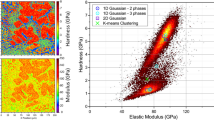Abstract
The deformation and fracture localization characteristics are estimated by the methods of replicas, acoustic emission, metal magnetic memory, ultrasonic attenuation, microhardness, and electrical resistance. The relation between the estimated physical parameters on the one hand and the plastic zone size and the microcrack concentration in this zone, on the other, is considered.
Similar content being viewed by others
References
Nondestructive Control: A Handbook, Ed. by V. V. Klyuev (Mashinostroenie, Moscow, 2006), Vol. 7.
H. A. Richard and K. Benitz, “A loading device for the creation of mixed mode in fracture mechanics,” Intern. J. Fracture 22 (2), R55–R58 (1983).
A. A. Dubov, Al. A. Dubov, and S. M. Kolokol’nikov, Magnetic Memory of Metals and Control Devices: A Tutorial (ID Spektr, Moscow, 2012).
L. R. Botvina, V. P. Levin, M. R. Tyutin, and N. A. Zharkova, “Heat capacity of deformed steels,” Dokl. Akad. Nauk 434 (5), 612–615 (2010).
S. N. Zhurkov, V. S. Kuksenko, and A. I. Slutsker, “Formation of submicroscopic cracks in polymers under load,” Fiz. Tverd. Tela 11 (1), 296–302 (1969).
L. R. Botvina, N. A. Zharkova, M. R. Tyutin, A. P. Soldatenkov, Yu. A. Demina, and V. P. Levin, “Development of plastic zones and damage at various types of loading,” Zavod. Lab. 79 (5), 45–56 (2013).
T. Shiotani, J. Bisschop, and J. G. M. van Mier, “Temporal and spatial development of drying shrinkage cracking in cement-based materials,” Eng. Fracture Mechanics 70, 1509–1525 (2003).
A. Carpinteri, G. Lacidogna, and S. Puzzi, “From criticality to final collapse: evolution of the “b-value” from 1.5 to 1.0,” Chaos, Solitons and Fractals 41 (2), 843–853 (2009).
L. R. Botvina, Fracture: Kinetics, Mechanisms, and General Laws (Nauka, Moscow, 2008).
M. R. Tyutin, L. R. Botvina, N. A. Zharkova, T. B. Petersen, and J. A. Hudson, “Evolution of damage in low-carbon steel in tension condition,” Strength, Fracture and Complexity, No. 3, 73–80 (2005).
E. S. Gorkunov, S. V. Smirnov, S. M. Zadvorkin, D. I. Vichuzhanin, and S. Yu. Mitropol’skaya, “Effect of cumulative shear deformation and damage during torsion on the magnetic properties of steel,” Fizicheskaya Mezomekhanika 7 (2), 311–314 (2004).
E. S. Gorkunov, S. V. Smirnov, and S. S. Rodionova, “Effect of plastic deformation under hydrostatic pressure on the damage and magnetic properties of lowcarbon grade 3sp steel,” Fizicheskaya Mezomekhanika 6 (5), 101–108 (2003).
V. T. Vlasov and A. A. Dubov, Physical Fundamentals of the Metal Magnetic Memory Method (Tisso, Moscow, 2004).
V. L. de Araujo Freitas, V. H. C. de Albuquerque, and S. E. de Macedo, “Nondestructive characterization of microstructures and determination of elastic properties in plain carbon steel using ultrasonic measurements,” Mater. Sci. Eng. A. 527 (16/17), 4431–4437 (2010).
A. A. Karabutov, N. B. Podymova, and E. B. Cherepetskaya, “Measurement of the dependence of local Young’s modulus on the porosity of isotropic composite materials by a pulsed acoustic method using a laser ultrasonic source,” PMTF 54 (3), 181–190 (2013).
A. Badidi Bouda, A. Benchaala, and K. Alem, “Ultrasonic characterization of materials hardness,” Ultrasonic 38, 224–227 (2000).
B. R. Tittmann, O. Buck, L. Ahlberg, M. de Billy, F. Cohen-Tenoudji, A. Jungman, and G. Quentin, “Surface wave scattering from elliptical cracks for failure prediction,” J. Appl. Phys. 51 (1), 142–150 (1980).
A. Badidi Bouda, H. Belhelfa, V. Jerir, and R. Khalimi, “Nondestructive method of estimating the carbon content in steel,” PMTF 55 (3), 174–180 (2014).
L. Botvina, L. Ju. Fradkin, and B. Bridge, “Power laws and generalized dimensional analysis in ultrasonic NDE,” Nondestr. Test. Eval. 12, 103–118 (1995).
K. V. Kurashkin and V. V. Mishakin, “Ultrasonic estimation of residual stresses,” Zavod. Lab. 79 (4), 54–58 (2013).
F. M. Mitenkov, V. V. Mishakin, S. N. Pichkov, V. A. Klyushnikov, and N. V. Danilova, “Use of optical and acoustic control methods for estimating the damage of steel at the early stages of fatigue fracture,” Zavod. Lab. 75 (12), 40–45 (2009).
L. R. Botvina, N. A. Zharkova, M. R. Tyutin, T. B. Petersen, and V. G. Budueva, “Acoustic properties of low-carbon steel at various stages of fracture,” Deformatsiay Razrushenie Materialov, No. 4, 35–41 (2005).
C. M. Suh, R. Yuuki, and H. Kitagawa, “Fatigue microcracks in a low carbon steel,” Fatigue Fract. Eng. Mater. Struct. 8 (2), 193–203 (1985).
K. J. Miller, “The behavior of short fatigue cracks and their initiation. Pt II. A general summary,” Fatigue Fract. Eng. Mater. Struct. 10 (2), 93–113 (1987).
M. W. Brown and K. J. Miller, “Initiation and growth of cracks in biaxial fatigue assessments of metals,” Intern. J. Fatigue 18 (4), 231–246 (1996).
I. I. Novikov, Thermodynamics of Spinodals and Phase Transitions (Nauka, Moscow, 2000).
I. I. Novikov, V. V. Aleksandrov, A. N. Borzyak, S. V. Boyarskii, V. G. Goncharov, T. I. Orlova, V. V. Roshchupkin, and N. A. Semashko, “Experimental determination of the heat capacity of structural materials,” in Structural and High-Temperature Materials for New Engineering (Nauka, Moscow, 1978), pp. 166–178.
L. A. Sosnovskii, N. A. Makhutov, A. M. Bordovskii, and V. V. Vorob’ev, “Methods for estimating the degradation of materials and structures,” Zavod. Lab. 69 (11), 40–49 (2003).
V. A. Lomantsov, “Development of a method for diagnostics of the oil-and-gas equipment used in hydrogen sulfide–containing media by analyzing the embrittlement of materials,” Candidate’s Dissertation in Engineering (Moscow, 2013).
E. E. Zorin and N. E. Zorin, “Microindentation-based rapid diagnostics of the mechanical properties of welded structures during long-term operation,” Svarka Diagnostika, No. 5, 25–29 (2009).
Author information
Authors and Affiliations
Corresponding author
Additional information
Original Russian Text © L.R. Botvina, A.P. Soldatenkov, V.P. Levin, M.R. Tyutin, Yu.A. Demina, T.B. Petersen, A.A. Dubov, N.A. Semashko, 2016, published in Metally, 2016, No. 1, pp. 27–39.
Rights and permissions
About this article
Cite this article
Botvina, L.R., Soldatenkov, A.P., Levin, V.P. et al. Assessment of mild steel damage characteristics by physical methods. Russ. Metall. 2016, 23–33 (2016). https://doi.org/10.1134/S0036029516010067
Received:
Published:
Issue Date:
DOI: https://doi.org/10.1134/S0036029516010067




